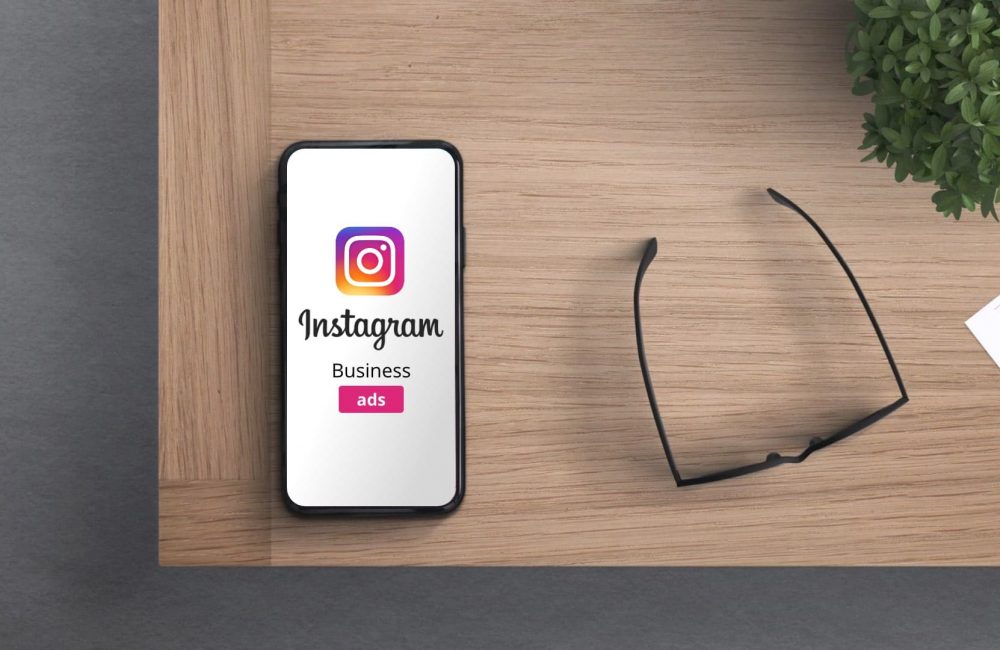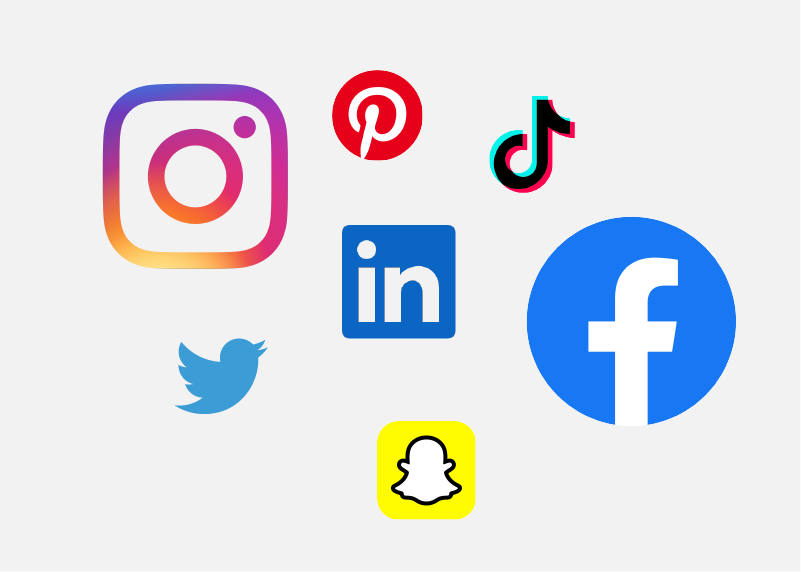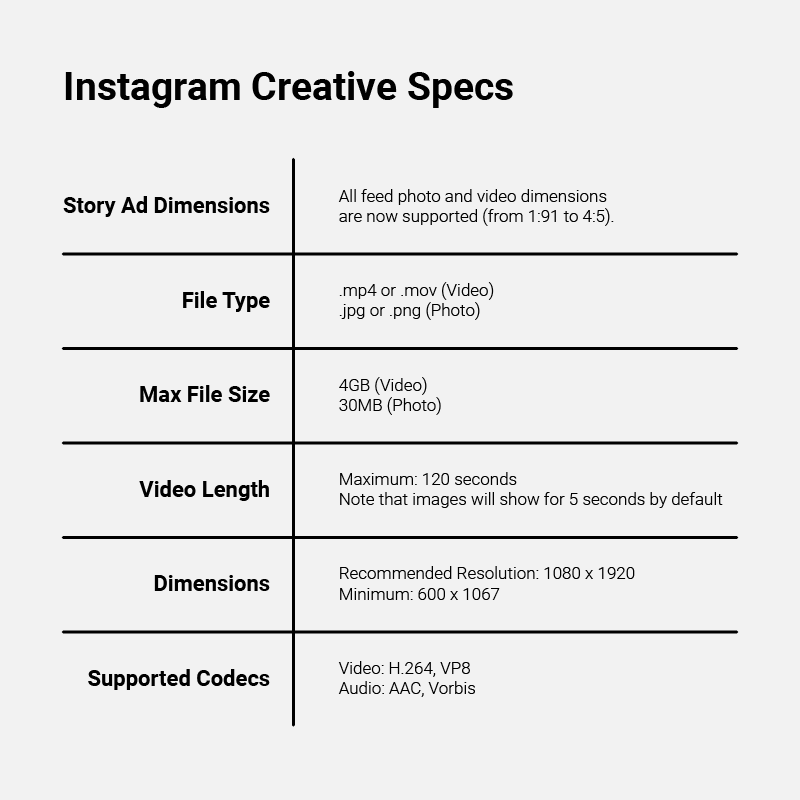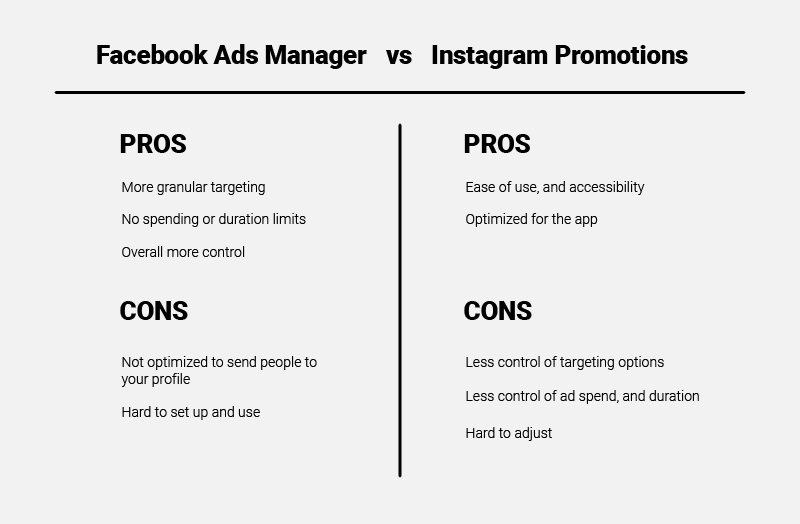Introduction to Instagram Advertising for Businesses
Social media marketing is an integrated marketing strategy that includes a balanced mix of paid and organic content. This mix of media is distributed throughout various social media platforms like Facebook, Instagram, Twitter, Snapchat, etc. Social media marketing (SMM) enables marketers to bridge the gap between an organization and its desired target audience. Successful social media marketing strategies carefully gather the attention of new prospects, typically through the use of paid media.
Paid media can include advertisements, influencer partnerships, or boosted posts – including Instagram Advertising. This newly acquired audience is then thoughtfully mobilized from cold prospects into warmer leads, with a balanced mix of organic content that nourishes, and paid media that guides. Finally, a successful strategy ushers those warmed up leads into loyal brand supporters with continued organic nourishment, and additional paid media, if necessary.
As you can see, a comprehensive integrated approach is necessary to acquire new customers, however, one of the biggest challenges small businesses face is getting in front of the right audience. You might have the world’s greatest product or the most aesthetically pleasing brand, or you may even have some brilliant pieces of content, but if you don’t know how to get in front of the people who need or want your product or service, it is all for not.
Stop Wishing, Start Strategizing.
Many marketers and business owners think of traffic as the rain. They give it their best guess, cross their fingers, and hope that the traffic will come. But a marketing strategy based on hope will not sustain. Thankfully, there is a way that can virtually guarantee you traffic to a broad range of potential customers. The type of traffic we are going to talk about is like a faucet. You can turn it on whenever you need to. This article will show you exactly how to get in front of the people you need to be in front of at any given time, and how to do it in a way that will generate hyper-targeted, smoking hot leads.
Instagram is one of the world’s fastest-growing social media and advertising platforms, with over 1Billion active monthly users worldwide. This article aims to inform marketers why they should be using Instagram advertising to reach and grow their audience. It will also serve to educate marketers on how to advertise effectively on the platform.
Instagram Advertising
What if access to your target audience was readily available to you? What if, at the press of a button, you would be guaranteed placement in front of someone who exhibits the behaviors and interests of your target demographic? Instagram advertising has made that possible. Worldwide, Instagram has more than 500 million users active on any given day. Whether your demographic includes high-level B2b decision-makers, or everyday consumers, most likely your audience, at some point during the day, is online scrolling through their Instagram feed. Quite amazingly, you have the ability to reach them at the press of a button through Instagram advertising.
Why Do I Need to Pay For Media?
There is a massive misconception about Instagram that is hurting a lot of small businesses. Because of this misconception, businesses utilizing Instagram are repeatedly making one of the gravest mistakes you can make in marketing – assault. We’ll explain.
The misconception is: The followers and audience you have accumulated will see what you post.
Further, and more critically, because businesses have this belief, they flood their feeds with sales-y, greedy content and media, that is turning away people that already love and support their brand. Many marketers and business owners consider Instagram to be a mass media outlet, i.e. 1 to many, when in reality it is a one to one relationship with the end-user. (Think about it, they are sitting on their couch half-watching Netflix when they are scrolling through their feed, not in a stadium at a rock n roll concert.)
Firstly, you are not guaranteed placement in front of someone just because they follow you. Instagram (and Facebook) have spent a lot of time and money building a platform that most people in the world use. For a small and glorious period, when these platforms were still developing and collecting data, we DID have nearly complete organic exposure to our audiences, however, those days are long gone. Now that Facebook and Instagram have provided us with proof that our audiences are indeed on these platforms, facebook and instagram, of course, are going to ask us to pay to get in front of said audiences.
Stop Selling, Start Nourishing.
We will get more in-depth with this in the next section, but your feed isn’t meant to sell, it is to nourish your current audience with the content that they want and need. Of course, you need revenue, and Instagram advertising can be your vessel.
With paid media, you can send ads to different segments of your audiences based on where they are in the customer acquisition journey. Instead of invading their leisure time on Instagram, screaming about yourself on your feed, you can meet them where they are at with the appropriate targeting, copy and creative in the form of an Instagram advertisement.
The Customer Acquisition Journey
Digital Marketing can seem very techy and machine-y, and can definitely feel overwhelming. At its core, though, digital marketing (DM) is just like a human relationship. And that is what your business is all about, right? The people you are serving. DM is the way to find those people, then build and nourish those strangers into a natural, organic friendship. Hopefully, one that lasts a long time. Understanding this relationship is perhaps the most vital part of marketing.
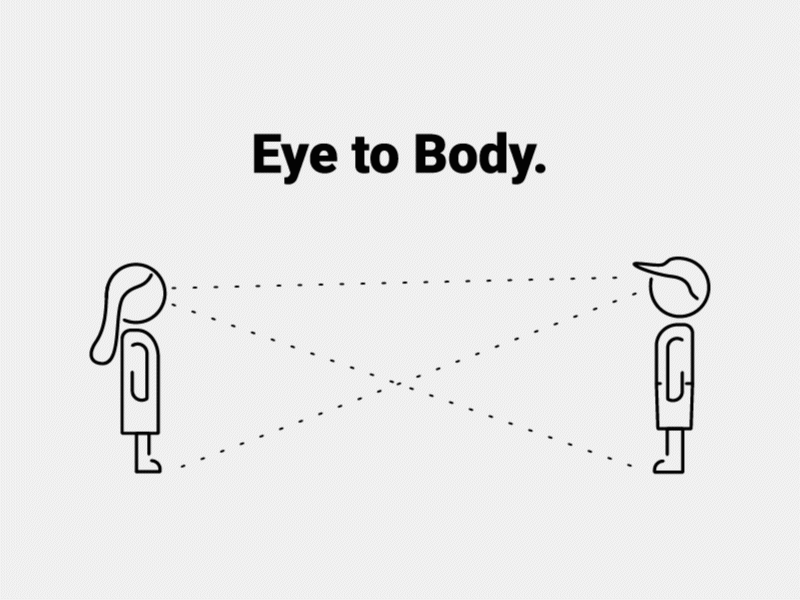
There are 12 phases of human intimacy, and your goal is to figuratively get to number 5 with your audience:
- Eye to Body – You notice the person. You are interested.
- Eye to Eye – Your eyes meet. You notice each other. You are interested in each other.
- Voice to Voice – You talk, call, text, email. This should be a pretty long stage. You start emotionally bonding.
- Hand to Hand – You hold hands. It may be an accidental touch that is kept in contact or deliberate. You are special.
- Hand to Shoulder – You put your arm around their shoulder. This publicizes your relationship.
In marketing terms, this relationship means delivering the correct piece of content, to the correct person at the correct time. It is in this process that many companies fail. For most people, if two or more of these phases are skipped at a time (and even just one), well, that is typically considered assault. That is what many companies are figuratively doing with their marketing. Knowing this, it is imperative to understand what type of marketing assets to send to whom and when, and how to send it to them. Broadly, we can separate our audiences into three segments: Cold, Warm and Hot.
The Marketing Funnel
In Marketing Funnel terms, our cold audiences (strangers that we think might be interested in us) are placed at the Top Of The Funnel, or as we like to say TOFU. Our warmer audiences, (those whom we have engaged with a few times and they have so far chosen to stick around) are pooled into the Middle of The Funnel (MOFU) and our Hot audience (the folks ready to give you their money and tell the world about you) we place in the Bottom of The Funnel (BOFU). In other words, you can categorize your audiences into an acronym: U-P-S-Y-D.
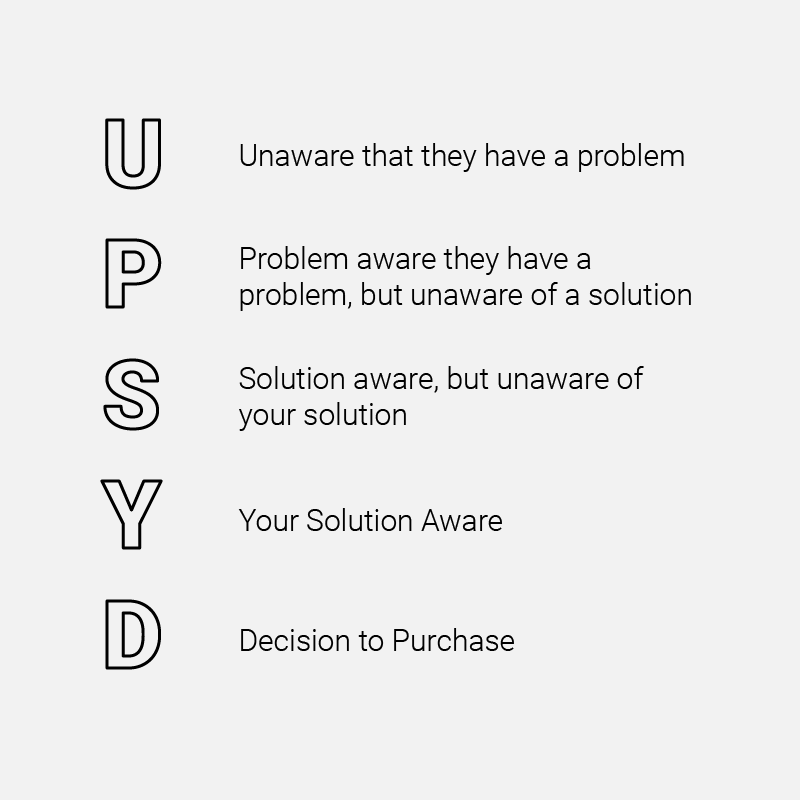
- U– Unaware that they have a problem:
- P– Problem Aware- Aware they have a problem, but unaware of a solution:
- S– Solution Aware, but unaware of your solution:
- Y– Your Solution Aware
- D – Decision to Purchase
Instagram Advertising Considerations
Understanding this customer acquisition journey is vital. You don’t want to send a top of the funnel advertisement, to someone who is warmed up and ready to make a purchase decision. Adversely, you don’t want to send a call to action ad (bottom of the funnel) to someone you just met (cold prospects). In both cases, you risk losing a customer.
Considering this customer acquisition journey, you are now ready to start building an Instagram ad. Before you get into the mud, there are 5 essential aspects to creating an effective ad that converts.
- Objective: Awareness, Consideration, or Conversion
- Creative: Photo, multiple photos (carousel), or video.
- Copy: This is the text within your ad that will help communicate the message to the end-user.
- Placement: On Instagram, you can place an ad on the stories, feed, or explore page.
- Targeting: After you’ve mastered all of the above, you must execute your targeting. If you send an ad to the wrong group of people, nothing above will matter.
Instagram Advertisement Objective
Selecting the advertising objective should be informed by who you are talking to for the specific ad. Facebook (and Instagram) have divided the advertising objectives into three categories: Awareness, Consideration, and Conversion. If you are targeting a cold audience, you want to send them an advertisement that is awareness-based. This is the ad that will grab the attention of the new audience member. That is the sole purpose, to either entertain, educate, or inspire, all with the goal of capturing attention. Anything beyond that can be detrimental to your campaign.
On the other end of the funnel, there are conversion-based ads. This objective should be reserved for audience members that have been properly warmed up through the funnel. Consideration objectives should be sent to warm leads. These ads are typically utilized to gather information, like an email or phone number.
Instagram Advertisement Creative
What many marketers fail to understand is that the last thing someone wants to see is an ad screaming in their face. They are in their living room or on the toilet, just searching for something entertaining to make them laugh or cry. Your creative should take this into consideration. Think about your consumer, and what they are interested in. Build your ad creative to match those interests. You want to show up in their feed as organically as possible, as if you were just a friend posting a video or image on your feed.
Psychologically, when someone feels they are being sold to, their guard immediately goes up. Your creative should take this into consideration. Think about the things you like and re-share on your own personal social media accounts. They are typically pictures or videos from someone’s phone. They contain an organic essence to them, that encourages engagement.
Creative Specs: Information directly from Facebook
There are three different ad placements on Instagram: Stories, Feed and Explore. While all Feed dimensions are supported, we recommend using a 9:16 aspect ratio to fit the fullscreen vertical format of Stories. To ensure you’re creating high-quality ads on Instagram, keep the following design requirements in mind.
- Ads in Stories
- All feed photo and video dimensions are now supported (from 1:91 to 4:5).
- File type
- .mp4 or .mov (Video)
- .jpg or .png (Photo)
- Maximum File Size
- 4GB (Video)
- 30MB (Photo)
- Video Length
- Maximum: 120 seconds
- Note that images will show for 5 seconds by default
- Dimensions
- Recommended Resolution: 1080 x 1920
- Minimum: 600 x 1067
- Supported Codecs
- Video: H.264, VP8
- Audio: AAC, Vorbis
All feed photo and video dimensions are now supported (from 1:91 to 4:5).
Instagram Advertisement Copy
The advertising copy is the main text used in the ad. For Instagram advertisements, this will be the caption. As with your objective, and creative, your advertising copy should also be informed by who you are talking to within the customer acquisition journey. If you are talking to a stranger, instead of talking about yourself, compliment them, or find a way to relate to them based on their interests. The goal is to make them aware of you, not to convert at this stage.
Once you have properly guided them through the funnel, you can talk to them as if you were talking to a good friend. At this stage, you have developed some equity in the relationship. Only then can you ask them for a “favor” AKA to buy your product.
In each case, whether you are talking to a hot lead, or a brand new prospect, keep in mind that users will only see a small amount of the text initially. A strong opening sentence in your ad copy can encourage the user to click the “more” button, allowing them to see the extended copy which will include your call to action. The “call-to-action” in your copy should guide the user to the “call-to-action button”. Based on your objective, there are different call to action buttons you can select, from “Learn More” to “Shop Now”, and everything in between.
Instagram allows for 2,000 characters in the extended advertising copy.
Instagram Advertisement Placement
*All information acquired directly from Instagram

- Feed Ads
- Photo Ads: Tell your story through a clean, simple and beautiful creative canvas. Photos can be in square or landscape format.
- Video Ads: Get the same visually immersive quality as photo ads—with the added power of sight, sound, and motion. And now, you can share videos up to 60 seconds long in landscape or square format.
- Stories Ads
Complement your feed content with ads on Instagram Stories. 500 million Instagram accounts use Instagram Stories every day. And businesses are seeing success with stories ads for a range of objectives. - Carousel Ads
Bring another layer of depth to campaigns where people can swipe to view additional photos or videos in a single ad. - Collection Ads
You can use Collection to visually inspire and help your audience discover, browse and purchase products. Tell an integrated story with a product or lifestyle focus, through video, images or both. - Ads in Explore
Reach people in a discovery mindset by extending your feed ads to audiences who are looking to expand their interests beyond the accounts they follow. Learn more here, or get started right away by creating your own ad.
Instagram Advertising Targeting
While users are scrolling, Instagram is collecting powerful insights from simple demographics, to more targeted data like interests or job functions. We can utilize this powerful collection of data to inform our advertising copy and creatives so that our advertisements are delivered to the correct people, and in a way that resonates with our desired target audiences.
All aspects of the Instagram ad are critical, however, if you perfect all of the above, but send the ad to the wrong group of people, you have just wasted valuable time and money. Before you start selecting interests and behaviors to target, get to know your audience’s interests intimately.
Most organizations grab the low hanging fruit with interest targeting. For example, if a golf apparel company was building out an audience, the temptation would be to select people who are interested in Tiger Woods, as that is a given. People who like golf, probably like or know of Tiger Woods. However, Tiger Woods is a massive celebrity, and everyone knows who he is. Instead, try to think of the interests only people who golf would know. What magazines are they reading? Who are the niche golfers that only true golfers are fans of? What events do recreational golfers attend? Ask yourself these questions to get into the mind of the end user.
Utilize Your Email Lists
You also have the ability to reach your current customers through Facebook and Instagram advertisements, by utilizing facebook ad managers Custom Audience feature. All you need to do is upload your current customer email list. If those emails correlate with the customer’s email associated with Facebook, then you can reach them directly for remarketing and follow up ads.
The Facebook ad machine also has the power to find people who exhibit the behaviors of your current customers. This is called a lookalike audience. Based on your customer email list, or people who have interacted with a previous ad, facebook will analyze their data, and find people who are like them that you haven’t reached yet.
The targeting options on Instagram are expansive, and can get as granular as is needed for the audience you are trying to reach.
Targeting Options on Instagram
- Location: Target people based in specific locations like states, provinces, cities or countries.
- Demographics: Narrow your audience based on information like age, gender and languages.
- Interests: Reach people based on interests like apps they use, ads they click and accounts they follow.
- Behaviors: Define your audience by activities they do on and off of Instagram and Facebook.
- Custom Audiences: Run ads to customers you already know based on their email addresses or phone numbers.
- Lookalike Audiences: Find new people who are similar to your existing customers.
- Automated Targeting: Instagram will help you quickly create an audience who might be interested in your business using a variety of signals including location, demographics, and interests.
Where to create an Instagram Advertisement: Facebook Ads manager VS. IG Promotions Pros and Cons
There are two ways to create an instagram advertisement. You can create an ad directly through the instagram app by clicking the “promote” button located underneath each post on your feed, or you can build the ad through the facebook ads manager which is located in the business manager. There are pros and cons to both.
Building an ad Natively in the Instagram App:
In order to promote posts within the Instagram app, you first need to have a business profile that is associated with a facebook business page. Navigate to the post you would like to promote, tap on the post, then click the “promote” button. Instagram will ask you where you would like to send people to: The options are Your Profile, Your Website, or Your Direct Messages. You will then be prompted to select an audience to send the promoted post to. Instagram has an automatic option, which targets people who exhibit similar behaviors to your current followers. You also have the option to build your own audience with interests, location, and demographics. After your target is selected, you select your daily budget, and for how long, then submit for review.
The Pros:
- Ease of use, and accessibility. Creating an ad is a fairly simple process within the app.
- Optimized for the app: When running promotions to gather top of funnel prospects, the in-app call to action option “visit instagram profile” is more enticing, and less of an intimidating ask than the ads manager option of “learn more”. When someone sees “learn more”, they don’t know exactly what they are clicking on, whereas when they see “visit instagram profile” they know exactly where they are going.
The Cons:
- Less control of targeting options. Currently, when promoting within the app, Instagram does not allow you to use custom audiences, or lookalike audiences that you have built in the ads manager.
- Less control of ad spend, and duration: Instagram promotions only last 30 days, and there is less control when it comes to how much you can spend. Once the 30 days is up, you have to re-create the ad, with the risk of sending it to people who have already seen it and acted on it.
Hard to adjust: There is no way to change audience, spend, or copy without deleting the promotion, and starting over.
Building an ad in the Facebook Ads Manager
Facebook Ads Manager lives within the business manager. Owning a business manager account will allow you to manage all of your pages, on instagram and facebook, from one place. To create an Instagram ad within the Facebook Ads Manager, first select your campaign objective. Set your budget, and select your audience. Facebook ads manager automatically selects all placements (on instagram and facebook) so you need to manually switch from “automatic” to “edit placements” and select Instagram only. Depending on your creative, it will automatically place it on stories, feed, and explore. If you are wanting to send people to your instagram profile, when prompted to enter a website link, just enter your instagram URL, and select a CTA.
Pros:
- More granular targeting: Through the ads manager, you can create more selective audiences, and target custom and lookalike audiences freely.
- No spending or duration limits: You can keep the ad running continuously, adjusting the spend whenever it needs to be adjusted, without interrupting the ad delivery.
- Overall more control: All aspects of the ad, from audience, to budget, duration, copy and creative are more accessible within the ads manager.
Cons:
- Not optimized to send people to your profile: There is no call to action button that explicitly says visit instagram profile, when building ads from the ads manager.
- Hard to set up and use: Creating a Business Manager account, along with an ad account is an extensive and complex process.
Influencer Marketing
One final source of paid media advertising you can execute on Instagram is Influencer Marketing. An influencer is anyone on instagram who has generated their own cult following. It can range from celebrities to bloggers, and everything in between. The benefit of partnering with an influencer is the direct access to their followers. Writing an ad that converts requires you to develop a relationship of trust with the end user. Instagram influencers have already developed that trust, so their followers are more open to hearing about products and services, because they trust who it is coming from.
According to the Harvard Business Review, around 18% of all consumers have purchased a product in the past year because it was promoted by an influencer on social media.
The key to partnering with an influencer is audience alignment. A skin care company, for example, should partner with an influencer in the skin care and beauty industry. Partnering with an influencer just because of their following is equivalent to sending an ad to the wrong audience.
When partnering with influencers, it is important to comply with FTC regulations. Because influencers have developed such a strong bond with their followers, it is important for them to be clear and transparent when posting a product they have been paid to endorse. The FTC requires any influencer with a material connection to the brand to clearly and obviously disclose that material connection any and every time they promote the product.
Conclusion
Instagram advertising can and should be integrated into your digital marketing strategy. If implemented properly, Instagram advertising can be a powerful tool in each phase of the customer acquisition process. With this knowledge, it is imperative to understand the 5 key elements of an Instagram advertisement: Objective, creative, copy, placement, and targeting. It is also of critical importance to understand the customer journey, and to know how to shape these 5 elements appropriately for each phase of the acquisition process.
Having an Instagram presence alone will not guarantee exposure to your audience. In fact, having a robust following on Instagram isn’t even required. Through the use of Instagram advertising, you have guaranteed access to a broad range of people, much more expansive than any number of followers, who exhibit the precise characteristics and behaviors of your target audience. You don’t have to sit and wonder how to get in front of the correct people, you have complete power and control to do that on your own.
